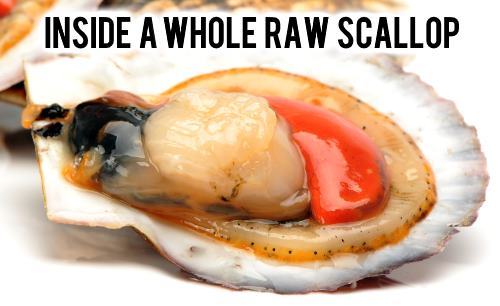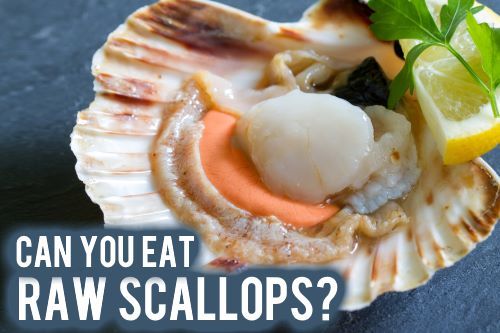Have you enjoyed scallops at a restaurant? Is it time to try preparing them at home? Fresh scallops are quite nutritious and can be a healthy source of protein if cooked carefully. No matter how you prepare your scallops, remember to never overcook them!
What Is A Scallop?
A scallop is a mollusk that propels itself across the ocean floor by forcing water through its shell. What does a scallop look like in the water? Scallop shells are quite pretty and have a ruffled edge.


What are sea scallops? The muscular tissue used to keep the scallop closed is actually the flesh that is served on your plate. This meat is white, though it may have a pink or orange tinge from the algae the scallop lives off of, or from the scallop roe or eggs.
Where Do Scallops Come From?
These mollusks are generally found in deep Atlantic waters, all the way from northern Canada down to North Carolina. There are also a few small Alaskan Bay scallops fisheries.
If you want large scallops with plenty of flesh, look for those harvested in the deep, cold waters of the Atlantic.
What Do Scallops Taste Like? Flavor Profile
When preparing scallops, it’s critical to avoid overcooking them; the naturally sweet flesh gets rubbery and bland.
There are two primary types of scallops available at most stores: sea scallops and bay scallops.
Sea scallops are larger and can be seared, while bay scallops serve better tossed in sauces or quick fried.
| Flavor | Scallops Taste |
|---|---|
| Sweet | Seared scallops have a steamy, sweet quality and deserve a 9 out of 10. Properly prepared, they are delicious, and just three large sea scallops will make a serving. |
| Sour | Your uncooked sea scallops should smell of the sea; fresh and slightly salty. Their sour rating should be 0 out of 10. If you notice a sour odor, avoid them. |
| Salty | Scallops are not naturally salty and only rate 2 out of 10. The searing process sweetens the flesh, though you can salt them a bit at the table. Avoid any heavy-handed seasoning of these delicious morsels. |
| Bitter | Scallops should rate 0 out of 10 for bitterness. However, if overcooked they can become dense and rather flavorless. |
Can You Eat Raw Scallops? Yes!
The term diver scallops refers to the method of harvesting. While most scallops are harvested mechanically via dredging, diver scallops are harvested by hand by divers, working along the bottom to pick the largest shells and leave the young behind.
Be aware that fresh scallops should be purchased from the seaside and be alive. Scallops can’t survive out of the water and are generally processed on the boat. There are some dangers of raw scallops that you should consider before consuming.

Can’t buy live scallops? Not all processed scallops are safe to consume raw. You will need to check the packaging or consult with your fish monger. When in doubt, cook them.
Some processors preserve scallops in a bath of STP (sodium tripolyphosphate) which can impact both flavor and weight. For raw scallops, look for dry-packed and flash frozen.
A word of warning: If you’re a fan of scallops and can’t wait to try them at your favorite sushi place, be aware that the texture of uncooked scallops is quite fatty. The flavor is fairly bland; fleshy with a bit of brine.
However, if you’re accustomed to the crisp flesh of a seared scallop, the fatty texture of sushi-grade scallops may be an unpleasant surprise.
Scallops Nutrition
Are scallops healthy? A three to five ounce serving of scallops contains about 100 calories. Be aware that a large, deep sea scallop can weigh an ounce on its own, while an ounce of bay scallops can be three to five pieces.
When it comes to vitamins and minerals, sea scallops are an important part of the diet of any Pescatarian thanks to their iron content. Many Pescatarians, or vegetarians that eat fish, struggle to get enough iron.
Health Benefits of Scallops
Are scallops high in cholesterol? Scallops are naturally low in fat and cholesterol. The fat they do contain is partially comprised of the omega-3 fat that can actually lower your cholesterol.
Monitor your cooking process to avoid the addition of unhealthy fat; if you play to sear your scallops, you’ll want to work with as little fat as possible and use a good non-stick pan to allow the flesh to caramelize without adhering to the hot surface.
It should be noted that there are health concerns for some diners:
1) Are scallops shellfish? Scallops are actually a mollusk but can still trigger a shellfish allergy. While Crustacea are a more common allergy, mollusk allergies can have dire consequences. If you’re allergic to shrimp, or lobster, you should avoid scallops.
2) Scallops live and feed off the ocean floor and can contain excess mercury, depending on where they’re farmed. Pregnant women and women planning a pregnancy should avoid raw scallops, and might want to avoid shellfish altogether. Bacteria can be neutralized by cooking; toxins cannot.
Bay Scallops vs Sea Scallops
The primary difference between bay and sea scallops is the size of each piece.
How many scallops in a serving? A serving of sea scallops is generally three pieces; a serving of bay scallops contains ten to twelve pieces.
The cooking method for these two types also differs. Remember, what diners call a scallop is actually the tough, fibrous material that clamps the shell shut.
If overcooked, it will toughen up and get fibrous very quickly, resulting in an unpleasant, chewy dish.
To sear sea scallops, you’ve got to make a little smoke. You can either:
- Dry your scallops and toss the scallops in oil or clarified butter before placing them in a hot frying pan.
- You can add oil to the pan and toss in the dry, salted scallops once the oil has reached a searing temperature.
Do not step away from the stove while searing scallops! You’ll be left with an expensive pan of burnt fish that chews like a bicycle tire. Keep them in the hot fat long enough to form a crust, then flip and cook the other side.
For bay scallops, cooking them in a sauce will give you the best results. The extreme heat of searing will destroy the small bay scallops. While it isn’t low fat, this make-ahead bay scallop casserole will make it your scallop preparation easy and delicious!
Final Thoughts
Scallops aren’t hard to find or cook, but you will want to invest in the best you can buy for your region.
If you find them, buy dry pack scallops that haven’t been chemically treated. Flash-frozen is better than wet-packed.
Thaw them gently; either by letting them thaw in the refrigerator or under cold running water.
Cook your large scallops for a short burst of time at high heat; you want a crust to form so the flesh will steam. Use a sauce to cook your bay scallops so they don’t get overheated and tough.
Did you enjoy this guide? Let us know if you like scallops, how you prepare scallops and your favorite scallop recipes.











